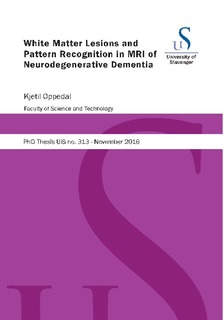White Matter Lesions and Pattern Recognition in MRI of Neurodegenerative Dementia
Doctoral thesis
Permanent lenke
http://hdl.handle.net/11250/2423144Utgivelsesdato
2016-11-03Metadata
Vis full innførselSamlinger
- PhD theses (TN-IDE) [20]
Originalversjon
White Matter Lesions and Pattern Recognition in MRI of Neurodegenerative Dementia by Ketil Oppedal, Stavanger : University of Stavanger, 2016 (PhD thesis UiS, no. 313)Sammendrag
Introduction
Expected age is increasing globally and dementia is a common outcome for an increasing number of
people. Dementia is a demanding syndrome for the patient and the environment as well as it is
costly for society. Damaging changes to the cerebral blood flow also called white matter lesions
(WML) are common in the elderly and is expected to increase as age advances. It has been reported
that these types of lesions affect cognition in healthy elderly. They are also associated to
Alzheimer’s disease but have not been much studied in DLB. Quantitative analysis and machine
learning have a potential to contribute in understanding the disease process as well as aid in
diagnosis.
Methods
Quantitative analysis of WML volumes were calculated using an automatic segmentation routine on
magnetic resonance images (MRI) of subjects with Alzheimer’s disease (AD), Lewy body dementia
(LBD), and normal controls (NC). Statistical tests were performed to compare groups as well as to
investi- gate relations to cognition. Additionally, WML volumes were used as features in a machine
learning (ML) environment to check whether WML volume were able to classify subjects with AD and
LBD from NC. Texture analysis (TA) may be able to document changes at a microstructural level and
was performed in WML an non-WML regions of the different types of MRI’s (FLAIR and T1). 2D- and 3D
TA features were calculated and used in classification with the aim to serve as a tool for computer
aided diagnosis (CAD) in dementia. The dataset used was imbalanced meaning that the number of
subjects in each group were very different. Two methods for handling the imbalanced data were
tested, namely upsampling and cost-sensitive classification.
Results and conclusions
Severity of WML did neither differ significantly between subjects with dementia and NC nor between
mildly demented patients with AD and LBD. WML severity were associated with cognitive decline in
AD, but not LBD suggesting that WML contributes to cognitive decline in AD, but not LBD. More
studies of the potential clinical impact of WML in patients with LBD are needed.
The best classification results obtained using WML volumes as features in an ML framework discerning
subjects with dementia from healthy controls were an area under curve (AUC) of 0.73 and 95%
confidence interval of 0.57 to 0.83.
We experienced better classification results when using TA features compared to WML volumes in
classification and better results when performing classifi- cation on TA features calculated from T1
MRI compared to FLAIR MRI. A total accuracy, reported as mean with standard deviation in brackets
over cross validation folds, of 0.97(0.07) or higher was reported for the dementia vs. NC, AD vs.
NC, and LBD vs. NC classification problems for both the 2D- and 3D texture analysis approaches. In
the AD vs. LBD case a total accuracy of 0.73(0.16) was reported using the 2D TA approach slightly
exceeded by the 3D TA approach were 0.79(0.15) was reported.
It seems like the results do not differ much when performing analysis in different regions of the
brain and that the results vary in an inconsistent way.
Using upsampling increased classification accuracy to a large extent in the LBD class at the expense
of total accuracy and the accuracy of the AD class. In both the two-class problems NC vs. AD and NC
vs. LBD, adding cost- sensitivity increased classification performance in many of the tests, but
upsam- pling increased accuracy even more in most of the tests.
High classification performance was achieved when classifying dementia groups from NC’s. The
classification performance reached when classifying AD from LBD did not reach the same level.
Further research with the aim of developing methods with a higher sensitivity to the different brain
changes going on in AD
and LBD are needed.
Beskrivelse
PhD thesis in Information technology
Består av
Ketil Oppedal, Dag Aarsland, Michael Firbank, Hogne Sønnesyn, Ole-Bjørn Tysnes, John O’Brien, and Mona K. Beyer: White matter hyperintensities in mild Lewy body dementia. Dementia and Geriatric Cognitive Disorders Extra, vol. 2, no. 1, pp. 481-95, 2012. https://www.karger.com/Article/FullText/343480Ketil Oppedal, Kjersti Engan, Dag Aarsland, Mona K. Beyer, Ole-Bjørn Tysnes, and Trygve Eftestøl: Using local binary pattern to classify dementia in MRI. 9th IEEE International Symposium on Biomedical Imaging (ISBI 2012), Barcelona, pp. 594-597, 2012.
Ketil Oppedal, Trygve Eftestøl, Kjersti Engan, Mona K. Beyer, and Dag Aarsland: Classifying dementia using local binary patterns from different regions in magnetic resonance images. International Journal of Biomedical Imaging, vol. 2015. http://dx.doi.org/10.1155/2015/572567
Ketil Oppedal, Kjersti Engan, Trygve Eftestøl, Mona K. Beyer, and Dag Aarsland: Classifying Alzheimer’s disease, Lewy body dementia, and normal controls using 3D texture analysis in magnetic resonance images. Biomedical Signal Processing and Control, Vol. 33, March 2017, pp. 19-29. http://dx.doi.org/10.1016/j.bspc.2016.10.007
Utgiver
University of Stavanger, NorwaySerie
PhD thesis UiS;PhD thesis UiS;313

